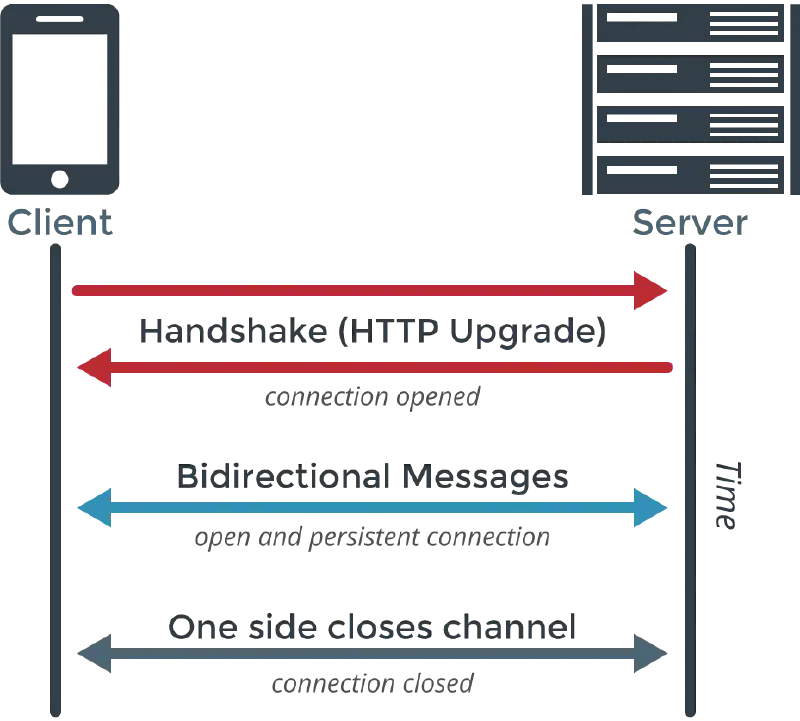Internet communication can be divided into two main types of APIs:
- Web Service APIs (e.g. SOAP, JSON-RPC, XML-RPC, REST)
- Web Socket APIs
HTTP #
HTTP/2: the difference between HTTP/1.1, benefits and how to use it
REST (REpresentational State Transfer) #
→ Establishes rules for HTTP.
- GET → Retrieve data
- PUT → Modify data
- POST → Add data
- DELETE → Delete data
HTTP Polling #
This can be imagined as a rabbit (Client) and a shopkeeper (Server).
HTTP Short Polling #
Requires constant querying. The rabbit keeps asking, “Do you have carrots?” every so often. The shopkeeper responds with “No” or “Yes” each time. The sequence looks like this:
00:00:00 Rabbit -> Do you have carrots?
00:00:01 Shopkeeper -> No.
00:00:03 Rabbit -> Do you have carrots?
00:00:04 Shopkeeper -> No.
00:00:06 Rabbit -> Do you have carrots?
00:00:07 Shopkeeper -> Yes, here you go.
00:00:09 Rabbit -> Do you have carrots?This method minimizes resource usage for both Client and Server but doesn’t provide real-time data. It also wastes network resources during the back-and-forth without guaranteed results.
HTTP Long Polling #
The shopkeeper waits until they have carrots to notify the rabbit, but if it takes too long, they eventually respond with “No.” The sequence is:
00:00:00 Rabbit -> Do you have carrots?
00:00:10 Shopkeeper -> No.
00:00:10 Rabbit -> Do you have carrots?
00:00:13 Shopkeeper -> Yes, here you go.
00:00:13 Rabbit -> Do you have carrots?This method delays both the shopkeeper and the rabbit, making them wait for each other’s response. While it eliminates latency, it’s inefficient for frequent updates.
HTTP Streaming #
Here, the rabbit decides to stay and wait. The shopkeeper updates the rabbit whenever something happens:
00:00:00 Rabbit -> Do you have carrots?
00:00:01 Shopkeeper -> Wait a moment.
00:00:02 Shopkeeper -> Carrots are coming soon.
00:00:03 Shopkeeper -> Yes, here you go.
00:00:03 Shopkeeper -> Waiting for the next delivery.
00:00:04 Shopkeeper -> Carrots are coming soon.
00:00:05 Shopkeeper -> Yes, here you go.
00:00:05 Shopkeeper -> Waiting for the next delivery.
00:00:06 Rabbit -> That's enough, thanks.This method might face delays due to proxy servers or firewalls buffering data.
SSE (Server Sent Events / EventSource) #
This is similar to HTTP Streaming, but the rabbit asks the shopkeeper to notify them only when there are carrots:
00:00:00 Rabbit -> Do you have carrots?
00:00:03 Shopkeeper -> Yes, here you go.
00:00:05 Shopkeeper -> Yes, here you go.
00:00:06 Rabbit -> That's enough, thanks.Both methods share a common issue noted by MDN:
When connections are not via HTTP/2, SSE is limited by the maximum number of concurrent connections, especially when multiple tabs are open. Each browser has its limit, which is usually low (e.g., 6).
Using HTTP/2 solves this, but not all browsers support SSE.
WebSockets #
Over time, the rabbit and the shopkeeper become friends and freely communicate:
00:00:00 Rabbit -> Do you have carrots?
00:00:01 Shopkeeper -> Wait a moment.
00:00:01 Rabbit -> Okay.
00:00:03 Shopkeeper -> Yes, here you go.
00:00:03 Shopkeeper -> Waiting for the next delivery.
00:00:04 Rabbit -> What's the flavor?
00:00:04 Shopkeeper -> Not sure, maybe carrot flavor?
00:00:05 Shopkeeper -> Carrots are coming soon.
00:00:05 Rabbit -> Great, these are delicious!
00:00:06 Rabbit -> I've had enough, thanks.Initially, they still use HTTP to establish a connection:

The Client sends a request to upgrade to WebSocket along with its key:
GET /chat HTTP/1.1
Host: example.com:8000
Upgrade: websocket
Connection: Upgrade
Sec-WebSocket-Key: dGhlIHNhbXBsZSBub25jZQ==
Sec-WebSocket-Version: 13If the Server agrees, it responds:
HTTP/1.1 101 Switching Protocols
Upgrade: websocket
Connection: Upgrade
Sec-WebSocket-Accept: s3pPLMBiTxaQ9kYGzzhZRbK+xOo=Since WebSocket uses a different communication protocol, it doesn’t occupy the HTTP channel.